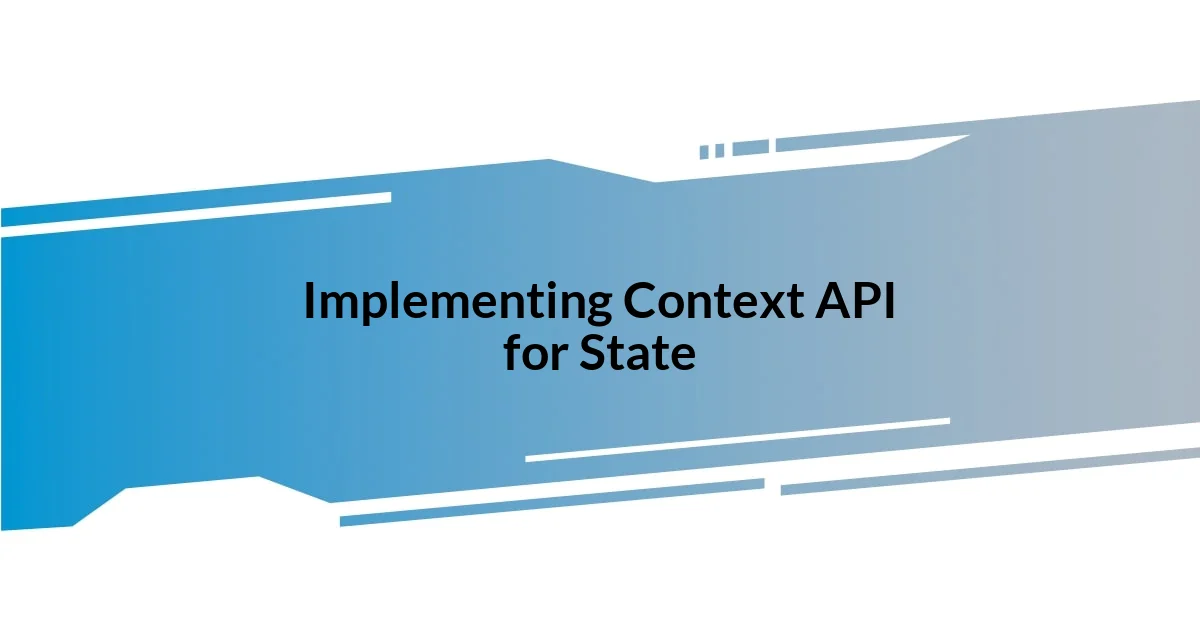Key takeaways:
- Understanding the difference between local and global state is crucial for effective state management in React, reducing complexity and improving user experience.
- Choosing the right state management tool, such as built-in hooks or libraries like Redux, depends on the application’s size, team proficiency, and performance needs.
- Implementing performance optimizations through memoization techniques (e.g.,
React.memo,useMemo) can significantly enhance application responsiveness and efficiency.

Understanding State Management Fundamentals
State management in React is essential for organizing and handling data flow smoothly throughout your application. I remember the first time I tackled state management; the light bulb moment came when I realized that understanding the difference between local and global state could save me from a tangled mess of props drilling. Isn’t it incredible how something as simple as a component’s state impacts the entire user experience?
Consider this: have you ever felt overwhelmed by managing multiple pieces of state in a complex app? That was me not too long ago. I learned to embrace tools like React’s built-in useState and useReducer hooks, which allowed me to manage state transitions with far less friction. It’s fascinating how these concepts can transform a chaotic codebase into a structured and maintainable one.
In mastering state management, the pivotal idea is to keep your components predictable. I often envision them as little machines that take input (state) and output (UI) based on that input. When I first implemented this mindset in my projects, I felt an immense sense of relief—it reinforced my understanding of how React truly works and helped me elevate my apps to the next level. How do you approach keeping your components’ behavior predictable?

Choosing State Management Tools
Choosing the right state management tool can be a game-changer for your React applications. Early on in my development journey, I found myself bouncing between different libraries, often feeling overwhelmed by the options. After some trial and error, I realized that the choice hinges on the complexity of my application and the team’s familiarity with the tools. Here’s what I consider when making that decision:
- Application Size: Smaller apps can thrive with built-in hooks, while larger ones might benefit from libraries like Redux or MobX.
- Team Experience: A familiar tool can save time, so I often opt for what the team knows best.
- Community Support: Established libraries come with extensive documentation and helpful communities, which is invaluable.
- Performance Needs: Consider how the tool impacts rendering and memory usage, especially in high-traffic applications.
When selecting a state management tool, I also reflect on past experiences where I overcomplicated my setup. For example, I once integrated a library that promised simplicity but instead added layers of complexity. That taught me the value of keeping things straightforward! Ultimately, the right tool should not just fit the project’s requirements but also feel intuitive and enhance both the developer’s and user’s experience.

Using built-in React State
Using React’s built-in state management offers a powerful yet straightforward way to handle component state. When I first started working with React, I was amazed at how the useState hook could manage the state without the need for a complex setup. It felt liberating to simply declare a state variable and a function to update it—this nearly eliminated the stress of tracking where my state lived. Have you ever experienced that ‘aha’ moment when you see how minimal code can lead to maximum results?
Of course, there’s more to built-in state than just useState. As my projects grew, I discovered the useReducer hook, which became my go-to for managing more complex state logic. I remember struggling with a component that required multiple state updates based on various user interactions. Switching to useReducer made all the difference, turning a tangled mess into a clear state machine. It’s incredible how a structured approach to state can reduce error-prone code and enhance overall maintainability.
While diving into built-in React state, I’ve learned to appreciate the nuances of managing performance alongside state. For instance, using multiple useState hooks can lead to unnecessary re-renders, impacting user experience. I recall optimizing a component where I replaced several useState calls with a single useReducer, resulting in smoother interactions. If you haven’t explored this approach yet, I’d highly recommend giving it a try.
| State Management Tool | Best Use Case |
|---|---|
| useState | Simple state management for individual components |
| useReducer | Complex state logic involving multiple sub-values |

Implementing Context API for State
Implementing the Context API can elevate how we manage state across components, especially in larger applications where prop drilling gets unwieldy. I remember a project where I was passing props through multiple layers of components just to get a piece of state to where it was needed. It felt like an endless game of telephone, and by the time the state reached its destination, it was out of sync. That’s when I turned to the Context API, and trust me, it was a game changer.
By creating a context, I was able to centralize state management, making the application not only more efficient but also easier to maintain. For instance, I set up a UserContext to share user data across different components without the hassle of prop drilling. It felt incredibly freeing to access the information I needed directly, almost like having a direct line to my state. Have you ever had that moment where everything just clicks? That’s what implementing the Context API felt like for me.
One key lesson I learned was the importance of performance—especially with provider re-renders. Initially, I thought just wrapping components in a Context Provider was enough, but then I noticed unnecessary renders impacting performance. To combat that, I got into the habit of memoizing the values passed through the Context. This small adjustment not only improved performance but also made my React apps smoother. It’s these little tweaks that can have a significant impact, and I encourage you to experiment and find the best practices that work for your projects!

Managing State with Redux
Managing state with Redux can feel like stepping into a new realm of state management that brings both power and complexity. I still remember the first time I integrated Redux into one of my projects; it was a learning curve that required me to shift my thinking. Instead of treating state as local to components, I began to see it as a centralized store, which drastically streamlined how I managed application-wide state. Have you ever felt overwhelmed by the number of state variables scattered across components? Redux can help eliminate that chaos.
One of the most impactful features of Redux is the use of actions and reducers. I recall the excitement I felt when I first implemented action creators. It was like giving my state a voice—each action truly encapsulated what needed to happen. For instance, in a recent app, I handled user authentication by dispatching actions like LOGIN and LOGOUT. The reducers handled these actions elegantly, updating the state in a predictable manner. This structure made debugging easier and gave me a sense of control that I hadn’t experienced with simpler state management strategies. Have you ever noticed how clarity in code can lead to greater confidence in your work?
That said, onboarding Redux into a project does demand careful consideration of performance. One lesson I learned the hard way was to avoid keeping too much data in the global store. I remember a project where I naively placed every slice of state into Redux, thinking it would simplify things. Instead, I encountered sluggishness during updates due to unnecessary rendering across multiple components. Now, I’m much more judicious about what goes into the Redux store. My rule has become: only share what truly needs to be shared. By striking a balance, I’ve found that I can harness the power of Redux while maintaining a smooth, responsive user experience.

Optimizing Performance with Memoization
There’s something quite empowering about understanding how memoization can enhance performance in a React application. I still remember the first time I learned about using React.memo to wrap my functional components. The immediate drop in unnecessary re-renders felt like a breath of fresh air—suddenly, components that didn’t need to update were left alone, allowing my application to run smoother. It made me reflect: how often do we forget to optimize our components, thinking they’ll handle state updates seamlessly?
Memoization, like useMemo and useCallback, truly shines when dealing with expensive calculations or functions that are re-created on every render. I recall implementing a costly filter operation in a list component that would trigger on prop changes. It quickly became a performance bottleneck. By wrapping that calculation in useMemo, I could ensure that it only recalculated when its dependencies changed. It felt satisfying to watch the app’s responsiveness improve—like tuning a fine instrument to get just the right sound.
Have you experienced sluggish performance with your app and wished for a quick fix? I’ve been there too. Now, I prioritize memoization as a vital part of my performance toolkit. Each time I apply it, I feel more in control of my application’s efficiency. It goes beyond just coding; it’s about fostering an experience that feels seamless and engaging for users. Memoization isn’t just a technical trick—it’s about creating a polished user journey, and it’s hard not to get excited about that!

Best Practices for State Management
When it comes to state management, one of the best practices I’ve adopted is to keep things simple and local whenever possible. I remember a project where I started with a complex global state structure, thinking it would make everything easier. However, that decision quickly backfired, leading to a tangled web of state updates. Now, I find that using local state for component-specific data not only reduces complexity but also improves performance. Have you found yourself overcomplicating state management in your applications? It’s a common pitfall, but stepping back and evaluating whether a piece of state truly needs to be global has made a huge difference.
Another crucial practice is to always make use of the built-in hooks in React. When I first discovered useReducer, it felt like finding the missing piece in my puzzle. Just like Redux, it allows for state management with the added benefit of being able to handle local component state more predictably. Recently, I used useReducer for a form where users could input data. The way I could manage the form’s state and its corresponding validations made it a breeze, while also keeping the component clean and readable. Have you explored how React’s hooks can simplify your state management? Dive into them, and you might just find your workflow becoming smoother and your code more maintainable.
Lastly, effective state management often calls for the right balance between synchronous and asynchronous operations. I’ve faced challenges where I tried to manage an API call directly in my component state, which led to some messy scenarios. I learned that using middleware, such as Redux Thunk or Redux Saga, can seamlessly handle these asynchronous actions. This separation has not only organized my code better but also allowed for effective error handling and loading states. How often do you think about structuring your asynchronous logic? Finding that balance has transformed the reliability of my apps, making them more responsive and user-friendly.
















